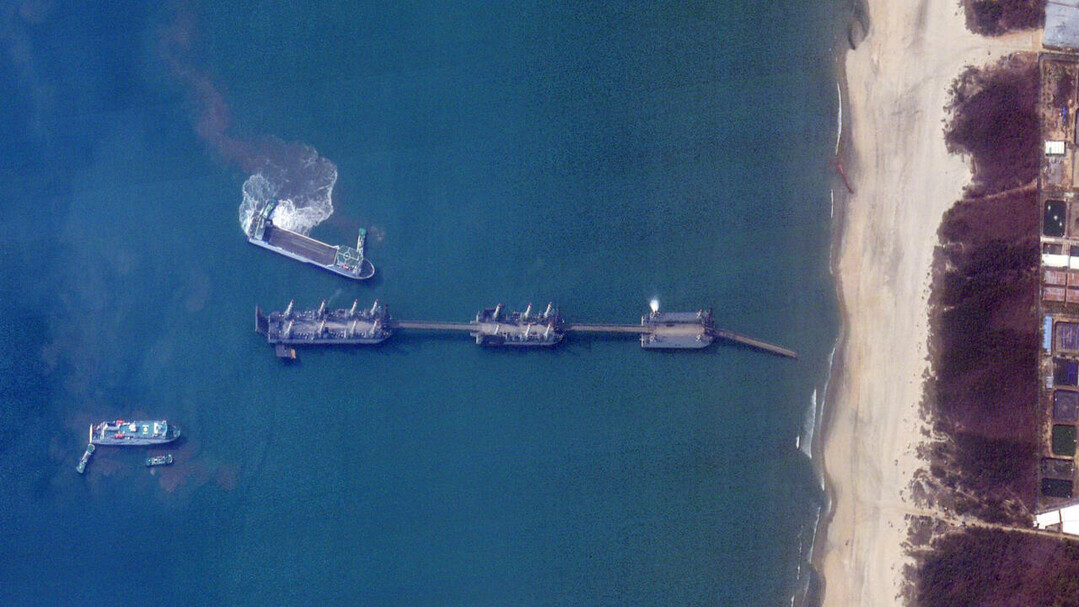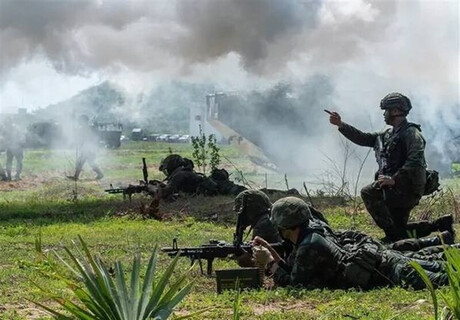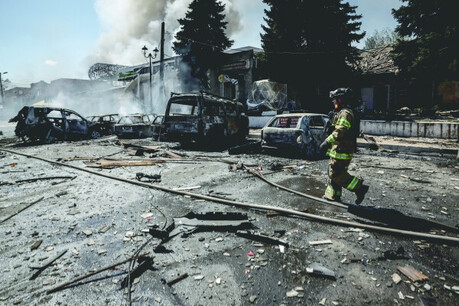
Defense experts are raising concerns over newly spotted large-scale barges off the southern coast of China, suggesting they could be utilized to land heavy equipment and thousands of troops in a potential invasion of Taiwan.
Beijing this week conducted so-called "punishment" drills around Taiwan, deploying fighter jets and warships in what appeared to be a rehearsal for blockading and attacking the self-ruled island.
Meanwhile, a memo from the U.S. Naval War College has indicated another potential weapon in Beijing's arsenal: barges that can be linked via expandable ramps to form an 820-meter-long pier extending from the deep sea to the shore.
The Naval War College suggests that these barges, equipped with retractable legs that can be anchored to the seabed, could provide a platform capable of landing troops and "hundreds of vehicles" on Taiwan within an hour.
"These barges are clearly designed for the purpose of facilitating an amphibious assault on Taiwan," stated Song Wen-ti, a nonresident fellow at the Atlantic Council's Global China Hub.
Wargames simulating a potential Chinese invasion of Taiwan have long assumed that the People's Liberation Army (PLA) would largely have to rely on smaller landing craft for an amphibious assault.
Only a limited number of Taiwanese beaches are considered suitable for large-scale landings, a factor that has historically provided Taipei with a significant defensive advantage.
"These barges could allow the PLA to land on more rugged parts of Taiwan's coastline," Song noted.
This, he added, would "offer the PLA a wider range of potential landing sites and have the effect of diluting Taiwan's defenses."
Satellite imagery from Planet Labs PBC revealed the deployment of this system off the coast of Zhanjiang in Guangdong province, southern China, late last month.
During a recent discussion about the barges on Chinese state television, military commentator Wei Dongxu highlighted their ability to transport large quantities of heavy equipment to the island "without getting their feet wet."
"Once our navy and air force have effectively controlled the air and sea, these...barges will appear," Wei asserted, calling them "a sign of victory."
The U.S. Naval War College has also reported that another three of these barge systems, which analysts have dubbed "Shuiqiao" (water bridge), are under construction in southern China.
"They show the seriousness with which Xi Jinping's China considers the imperative of annexing Taiwan, by any means necessary," commented Andrew Erickson, a professor at the U.S. Naval War College's China Maritime Studies Institute. "Beijing would not be wasting resources on such specialized and dedicated systems if it were not focused on coercing or conquering Taiwan."
Erickson further suggested that China's world-leading shipbuilding industry could rapidly construct many more such barges at a relatively low cost.
Beijing has intensified its military pressure on Taipei in recent years, conducting multiple large-scale drills around the island, often described as rehearsals for a blockade and potential invasion.
During this week's drills, Taiwan's defense ministry reported detecting 21 PLA warships, 71 aircraft, and four coast guard vessels operating around Taiwan on Tuesday.
The Chinese aircraft carrier Shandong also reportedly participated in the exercises.
The drills, which took place less than a month after Taiwanese President Lai Ching-te called China a "foreign hostile force," saw the PLA simulate strikes on "key energy facilities" and harbors, according to Chinese military statements.
Despite Beijing's rhetoric, overwhelming a well-prepared Taiwanese defense force and executing a successful invasion remains a significant challenge for the modernized PLA.
These barges are by no means a panacea for the logistical hurdles that a future invasion would entail.
The U.S. Naval War College itself pointed out that the barges "appear vulnerable to attacks from the sea, air, and land."
"There's a reason why these kinds of capabilities are not often known to be particularly viable," said Lora Saalman, executive director of the Asia Society Policy Institute's Center for Public Opinion and Foreign Policy.
"They are...hard to hide, hard to defend, and slow-moving," Saalman elaborated. "They would require air superiority to function, and it's unclear whether Beijing could achieve air superiority over Taiwan."
Erickson concurred, stating that the barges "could not survive in isolation."
While seemingly in the deployment testing phase, these barges may serve a purpose in signaling intentions to Taiwan's leadership.
"Beijing is saying, 'We are actively addressing what we perceive to be the problems associated with a large-scale Taiwan invasion,'" Saalman analyzed. "And the message is, 'You should be concerned about it.'"
Further Information:
Amphibious Warfare Capabilities of the PLA: The PLA Navy possesses a substantial fleet of amphibious landing ships and has been steadily enhancing its amphibious assault capabilities with the introduction of modern landing craft, such as air-cushioned vehicles (LCACs). However, the complex geography of the Taiwan Strait and the defensive readiness of the Taiwanese military present significant challenges for the rapid and secure landing of large numbers of troops and equipment.
Geographic Characteristics of the Taiwan Strait: The Taiwan Strait, while relatively narrow, features complex currents, unpredictable weather conditions, and a limited number of suitable landing beaches along Taiwan's western coast, all of which pose obstacles to amphibious operations.
Taiwan's Defense Strategy: Taiwan has developed a multi-layered defense strategy to counter a potential Chinese invasion. Key elements include the fortification of coastal defenses, the maintenance of mobile defense capabilities, and the leveraging of asymmetric warfare tactics. Particular emphasis is placed on deploying coastal mines, anti-ship missiles, and stealthy fast-attack craft to deter or repel PLA landing attempts.
Military Applications of Barges: While typically used for civilian cargo transport, barges can serve various military purposes. During World War II, the Allies utilized barges as temporary floating bridges during the Normandy landings. More recently, there has been growing military interest in barges for purposes such as constructing offshore bases and transporting heavy equipment.
China's Shipbuilding Industry Capacity: China possesses the world's largest shipbuilding industry, with significant capacity for constructing both commercial vessels and warships. This robust industrial base provides a considerable advantage in rapidly procuring large quantities of military equipment and transport assets in a contingency.
The emergence of these new Chinese barges can be interpreted as a novel attempt by the PLA to overcome the inherent difficulties of conducting a large-scale amphibious assault on Taiwan. However, experts caution that the vulnerability of these barges and the uncertainties of the operational environment mean they are unlikely to be a decisive factor guaranteeing the success of an invasion.
Nevertheless, China's development and deployment of such assets underscore its continued efforts to exert military pressure on Taiwan and signal its willingness to consider the use of force if necessary. The international community will undoubtedly continue to monitor China's military activities and the level of tension in the Taiwan Strait with close attention and concern.
[Copyright (c) Global Economic Times. All Rights Reserved.]






























